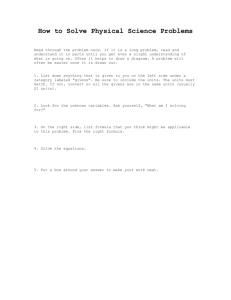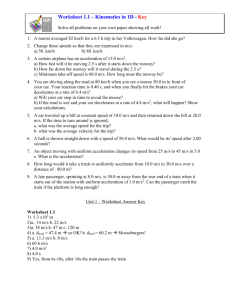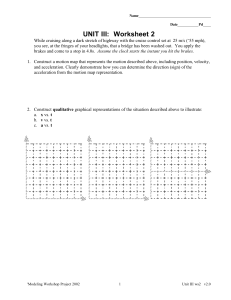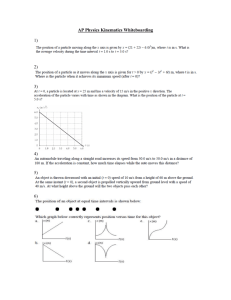Final Exam Review
advertisement
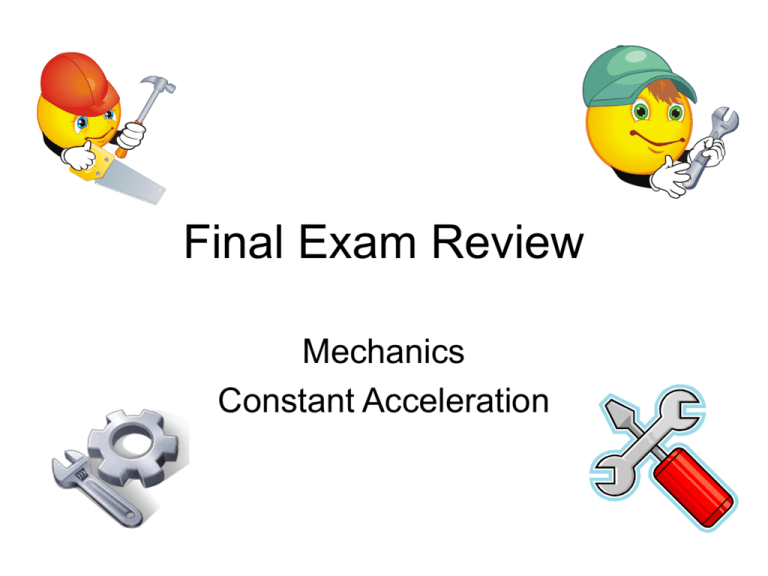
Final Exam Review Mechanics Constant Acceleration Average Acceleration • Formula: aavg = Δv / t • or • aavg = (vf-vi) / t • Both equations are equivalent, and either can be used when it’s convenient. Example • A shuttle bus slows down with an average acceleration of -1.8 m/s2. How long does it take the bus to slow from 9.0 m/s to a complete stop? Example • A shuttle bus slows down with an average acceleration of -1.8 m/s2. How long does it take the bus to slow from 9.0 m/s to a complete stop? • Givens a = -1.8 m/s2 • vi = 9.0 m/s • vf = 0 m/s Example • A shuttle bus slows down with an average acceleration of -1.8 m/s2. How long does it take the bus to slow from 9.0 m/s to a complete stop? • Givens a = -1.8 m/s2 • vi = 9.0 m/s • vf = 0 m/s • aavg=(vf-vi)/t → -1.8m/s2=(0 - 9.0m/s) / t • t = -9.0 / -1.8 = 5s Practice • Page 49- Practice B • Complete the FIRST TWO problems. Displacement with Const Accel. • Formula: Δx = ½ (vi+vf)t Example • A racing car reaches a speed of 42 m/s. It then begins a uniform negative acceleration, using its parachute and braking system, and comes to rest 5.5s later. Find the distance that the car travels during braking. Example • A racing car reaches a speed of 42 m/s. It then begins a uniform negative acceleration, using its parachute and braking system, and comes to rest 5.5s later. Find the distance that the car travels during braking. • Givens vi = 42 m/s • vf = 0 m/s • t = 5.5 s Example • A racing car reaches a speed of 42 m/s. It then begins a uniform negative acceleration, using its parachute and braking system, and comes to rest 5.5s later. Find the distance that the car travels during braking. • Givens vi = 42 m/s • vf = 0 m/s • t = 5.5 s • Δx = ½ (vi + vf) t → Δx = ½ (42m/s + 0m/s)(5.5s) • Δx = 120m Practice • Page 53- Practice C • Complete the FIRST TWO problems. Velocity AND Displacement with Const Acc. • Formula: Δx = vit + ½ at2 • vf = vi + at • Problems of this type are often two step problems (though not always) Example • A plane starting at rest at one end of a runway undergoes a uniform acceleration of 4.8 m/s2 for 15s before takeoff. What is its speed at takeoff? How long must the runway be for the plane to be able to take off? Example • A plane starting at rest at one end of a runway undergoes a uniform acceleration of 4.8 m/s2 for 15s before takeoff. What is its speed at takeoff? How long must the runway be for the plane to be able to take off? • Givens vi = 0 m/s • vf = ? a = 4.8 m/s2 Δx = ? t = 15 s Example • A plane starting at rest at one end of a runway undergoes a uniform acceleration of 4.8 m/s2 for 15s before takeoff. What is its speed at takeoff? How long must the runway be for the plane to be able to take off? • Givens vi = 0 m/s a = 4.8 m/s2 t = 15 s • vf = ? Δx = ? • Step 1 vf = vi + at → vf = 0m/s +(4.8m/s2)(15s) = 72 m/s Example • A plane starting at rest at one end of a runway undergoes a uniform acceleration of 4.8 m/s2 for 15s before takeoff. What is its speed at takeoff? How long must the runway be for the plane to be able to take off? • Givens vi = 0 m/s a = 4.8 m/s2 t = 15 s • vf = ? Δx = ? • Step 1 vf = vi + at → vf = 0m/s +(4.8m/s2)(15s) = 72 m/s • Step 2 Δx = vit + ½ at2 • Δx = (0m/s)(15s) + ½ (4.8m/s2)(15s)2 • Δx = 540 m Practice • Page 55- Practice D • Complete the FIRST TWO problems.

